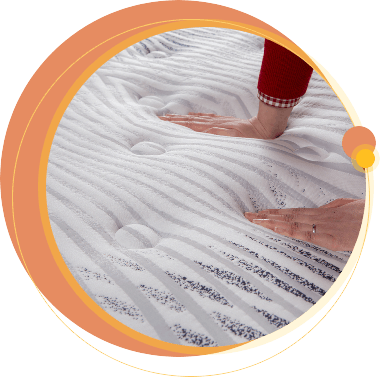
Is your mattress having a hard time delivering the level of comfort you’re after because it’s slightly too firm for your taste?
If the answer is yes, you’re dealing with an issue that needs to be addressed as soon as possible – given the fact that you spend a third of your day sleeping, comfort and support should be your top priority. So, you have two options here:
You could go down the easy (and expensive) route and buy a new one, or you could try and fix it yourself.
I know that spending a small fortune on a new mattress isn’t an option for everyone, though, so let’s try some of my other tips on how to make a mattress softer first, okay?
Let’s get started!
 Firm Vs. Soft Mattress: Which One’s Better For You?
Firm Vs. Soft Mattress: Which One’s Better For You?  Waking Up With Pain: Could Your Mattress Be The Cause?
Waking Up With Pain: Could Your Mattress Be The Cause?  Not Too Soft, Not Too Firm: When Opting For Middle Ground Is The Way To Go
Not Too Soft, Not Too Firm: When Opting For Middle Ground Is The Way To Go Infographic: How To Make Your Mattress Softer
Infographic: How To Make Your Mattress Softer How To Make A Mattress Softer: 8 Things You Should Try
How To Make A Mattress Softer: 8 Things You Should Try FAQ About Firm Mattresses And The Trouble They (Could) Cause You
FAQ About Firm Mattresses And The Trouble They (Could) Cause You
Firm Vs. Soft Mattress: Which One’s Better For You?

It’s tough to give a straight answer to a question like this because there’s no right or wrong answer here – picking the right firmness level is imperative for a good night’s rest, but it depends on a lot of factors, including:
Your weight and age
Your preferred sleeping position
Any existing back, neck, or hip pain
What works for some might not necessarily work for you, which is why I strongly encourage you to listen to what your body’s telling you, instead of following other people’s opinions on the matter. That’s why I decided to start this article with a sum up of advantages and disadvantages of both firm, as well as soft mattresses – it should help you make an informed decision on what might work best for you.
Firm Mattresses
A firm sleeping surface doesn’t sound very appealing, but the truth is, firm mattresses bring a wide range of benefits to the table!
Advantages
- By not allowing your body to sink in too far into the mattress, a firm sleeping surface encourages proper, neutral alignment of the spine. Keeping your body straight while you get your eight hours of rest during the night is essential for avoiding any unnecessary strain on your back.
- Proper spinal alignment isn’t only crucial for your back – the benefits extend to the entire body! When your whole body maintains excellent posture, your muscles don’t have to compensate for the less-than-ideal positions you find yourself in, and, as a result, you get to experience a deep, highly restorative rest – something owners of saggy mattresses can only dream of doing.
- Now, if I told you that sleeping on a firm mattress can also improve your circulation and oxygen intake, you’d probably think I’m overselling it, but the truth is, I’m not. As a result of putting less pressure on muscles and not letting your lower back collapse into the mattress, blood flow to all areas of the body will improve significantly, and you’ll be able to breathe more freely.
- Lastly, firm mattresses are a lot more customizable than their softer counterparts – you can always make a mattress softer with a few simple tricks, and I’m going to show you exactly how you can achieve that. Making a soft mattress firmer, on the other hand, is nowhere near as easy, so bonus points for customization go to the firm variety.
- If you prefer to sleep with a full-body pillow or like to place one between your knees, you should know that the firm mattresses are usually better at supporting the use of these types of “props”.
Disadvantages
- If you’ve recently made a switch from a soft mattress to a firm one, you can expect it to be quite uncomfortable initially. Give your body some time to get used to the transition – things should start looking up with time.
- If you’re suffering from chronic conditions that affect your lower back, such as arthritis, rheumatism, or scoliosis, you should steer away from hard mattresses because they can potentially exacerbate the pain, instead of improving your comfort level.
- Depending on your sleeping position, a hard mattress can do more harm than good by creating uncomfortable, and often quite painful pressure points that mainly affect your joints (shoulders and hips, for example). At the same time, it might not support your back properly, leading to poor spinal alignment.
- When it comes to firm mattresses, there’s an advertising issue you should keep in mind, as well. Not a lot of mattress manufacturers will label their products as „hard and solid“ because that doesn’t sound very comfortable to the average shopper, and they choose to advertise their mattresses as “soft“ or “plush“, instead. As a result, that same shopper could end up buying the wrong model, which is why some of you need a guide on how to make a mattress softer, in the first place.
- It could develop indentations with time, as a result of pressure your body weight is putting on the mattress.
Soft Mattresses
Nothing better than a soft, cozy mattress, right?
Well, let me know how you feel about it after you’ve gone through all the advantages and disadvantages listed below:
Advantages
- Their ability to reduce, or even eliminate back pain is, by far, one of the most significant benefits of soft mattresses.
As such, I strongly recommend them to anyone with a pre-existing back problem, as well as the elderly, who are often suffering from joint pain and other age-related conditions that prevent them from getting a good night’s rest on firmer sleeping surfaces. - On top of the previously mentioned back pain relief, soft mattresses seem to be a good choice for people suffering from conditions affecting the lower back in particular, such as scoliosis, rheumatism, and arthritis. If you’re one of them, I suggest switching to a softer mattress to avoid further aggravating the issue.
- Soft mattresses can strike that perfect balance between comfort and support, but keep in mind this benefit only holds for light sleepers.
So, if your weight is in the lower range, you get to enjoy the outstanding plushness and coziness soft mattresses are known for, without sacrificing proper spinal support in the process. - They are generally considered to be a better choice for side sleepers, particularly those of you that prefer to sleep in a fetal position. The reason behind it is that their plushness acts as a cushion for your joints, mainly the hips and shoulders, and in turn, helps remove pressure points.
Disadvantages
- Although firmness doesn’t equal support, as I’ve pointed out a million times before, I think we can all agree that a soft mattress might not be able to provide proper support to your body, and could push your spine out of alignment as a result.
It all depends on your body type and sleeping position, but as a general rule, people with higher weight, as well as back and stomach sleepers should steer away from soft mattresses, no matter how comfortable and luxurious they might seem at first glance. - If you have a sleeping partner, you already know how tricky it can be to find a mattress that works for both of you – and with soft beds, things get even more complicated. For instance, if one of you is significantly heavier than the other, it could create an unbalanced sleeping surface – and loss of sleep.
- All mattresses tend to soften up as time goes by – that’s perfectly normal, and is mostly an indicator of their quality. However, if you have a soft mattress, to begin with, there’s not much „wiggle room“ for your mattress’ firmness. There’s only so much firmness it can lose before it’s deemed unusable – and with soft ones, it can take only a couple of years.
- Soft mattresses also tend to become saggy and lumpy much faster than their firmer counterparts, which makes them a less-than-ideal long-term sleeping solution.
So, Which One’s Better?
Again, there’s no right or wrong answer here, mainly because we’re dealing with a firmness scale, rather than only two complete opposites. Furthermore, your choice of a mattress depends on a variety of factors, including your weight, preferred sleeping position, and any existing medical conditions that require you to stick to a specific firmness level.
If this doesn’t satisfy your curiosity, and you wish to learn more about different firmness levels, feel free to check out my guide on how to choose a mattress – you’ll find everything you need to know there!
Waking Up With Pain: Could Your Mattress Be The Cause?

If you keep waking up with soreness and pain in different areas of your body – be it your back, neck, or shoulders – pointing fingers left, and right can be a tempting thing to do.
But what’s at fault here? Your pillow? That uncomfortable office chair you spend your shifts in on a daily basis? Your sleeping position? Or could it be the mattress you spent a small fortune on recently?
The truth is, it might be all of the above. However, one sure way to tell if your troubles are mattress-related is to pay attention to what your body’s trying to say to you. If the pain is worse in the morning, when you’re fresh out of bed, but goes away as soon as you get up and start moving, I have bad news for you:
It’s time to take a good, hard look at your mattress because there’s something fishy about that whole scenario.
And here’s the thing:
More often than not, it’s the soft mattresses that cause these types of issues. I know a cozy, plush bed can be hard to resist – and it certainly sounds a lot more inviting than a firm one – but beware of all that squishiness. It can never provide the level of support your body needs to stay in a natural position throughout the night.
You’re probably growing tired of all the spinal alignment talk, but I can’t stress enough how essential it is for your overall well-being – everything starts at the spine.
A mattress on the firmer side is always the way to go – until it’s not. As mentioned previously, a soft sleeping surface is a good choice if you have a medical condition that’s affecting your lower back. But if an already existing medical condition isn’t the cause of your pain, you should probably stick to the firm side of the scale – you’d be surprised how big of a difference proper support makes!
Disclaimer: Although I try my best to give you only the best sleep advice for a better night’s rest, and weed out any misinformation you might’ve picked up along the way, you should remember that I’m not a doctor. If you’re suffering from chronic pain in your back or joints, I strongly encourage you to seek professional help and medical advice.
Not Too Soft, Not Too Firm: When Opting For Middle Ground Is The Way To Go

What about scenarios where neither “soft“ nor “firm“ is the right choice, though? Here’s all you need to know about aiming straight for the middle:
Side Sleepers
Before we go any further, here’s a fun fact for you:
Up to 74 percent of people admitted that sleeping on their side is their go-to sleeping position.
So, if you’re a side sleeper, congratulations – not only have you picked the most popular sleeping position of all but a healthy one, as well. And, as you can imagine, sleeping on your side bears different mattress requirements than those of back and stomach sleepers. They need a firmer sleeping surface that won’t compromise spinal alignment – but what about you?
Of course, the focus should always be on relieving pressure points and keeping your spine in the right position – if not addressed, these things will cause you a lot of trouble in the long run – but what does that mean when you translate it to mattress firmness?
For a side sleeper, it is essential to find a mattress that strikes the perfect balance between soft and firm – the middle ground, that is. If you go too far to the plush side, you’ll sink into the mattress, and if it’s too firm, it won’t contour to your body’s natural curves, which won’t make for a very comfortable experience, either.
That said, don’t forget to factor in your weight. The balance you’re after largely depends on your body type – the heavier you are, the firmer your mattress should be to prevent you from sinking in too deeply. Generally speaking, though, as a side sleeper, you shouldn’t go outside the medium range.
Moms-To-Be
If you’re expecting a baby, you’re probably well aware of all the rapid changes going on in your body, even as we speak. And it’s no wonder, either – it’s hard at work, growing a life inside you! How exciting is that?
However, another thing you might’ve noticed is that quality sleep seems hard to come by these days. And sadly, sleep disruption is, for a lot of women out there, an unavoidable part of the journey.
That said, I’m sure you know how essential it is to get enough sleep throughout the pregnancy, so why not do everything in your power to ensure you’re getting a good night’s rest – even if it means changing your mattress entirely? After all, you should provide the right support and comfort to your growing body!
Now, the trick is in defining what “right support and comfort“ mean when you’re a mom-to-be. Your body is changing day in and day out, and it might be hard to keep track – a sleeping surface that felt comfortable all your life (be it a hard or a soft one) might not work anymore. So, what are you supposed to do?
First, you need to remember that the mattress firmness level is a highly subjective thing, that often comes down to personal preference – no one can tell you what feels right to you, right? That said, there are some general guidelines most experts (and moms) agree on, the most important one being that the middle ground is your friend.
Steer away of the extreme ranges in the firmness scale – a soft mattress will seem all nice and cozy until it’s time to get out of bed, and a firm one could cause pressure build-up in your joints. That means you’re left with the medium firmness range, which still gives you a chance to tweak the firmness level a bit without going too far.
How To Make A Mattress Softer: 8 Things You Should Try

Okay, it’s time to get down to business – if your mattress doesn’t feel as cozy and comfortable as it used to, there are plenty of ways to address that (and yes, one of them is buying a new mattress, but we’ll get to that later).
So, without further ado, here’s how to make a mattress softer!
I figured it would be best to start with the solution to the most commonly seen scenario:
You bought a new mattress, but it doesn’t feel as soft as you expected.
Don’t worry; you didn’t buy the wrong one, and there wasn’t a mix up with the orders – it’s just your mattress being its brand-new self. It’s not that it’s uncomfortable – it’s unfamiliar, and that’s what’s genuinely bugging you here.
So, give the new kid on the block a chance to impress you before you decide to call the whole thing off, and go back to your old mattress. It will take time, and you’re setting yourself up for quite a few uncomfortable nights, but once you finally break it in, you’ll remember why you fell in love with that particular mattress, in the first place.
———-
How Long Does This Take?
I don’t mean to scare you off, but honestly speaking, it might take up to two whole months for the break-in period to be over, depending on the type of mattress. In ideal circumstances, it takes around 30 days, but with high-density memory foam, you might be looking at approximately eight weeks.
I know you probably think there’s no way you’ll be able to put up with it for such a long time, but trust me – it will get better. As days (or, rather, nights) go by, you and your mattress will grow more and more accustomed to each other. Keep up the good work, and you’ll be best buddies in no time!
———-
Tips For Breaking In A New Mattress
I’d like you to think of your mattress as a new pair of running shoes – you wouldn’t run a marathon in them without breaking them in first, now, would you?
Of course, you wouldn’t! The same applies to brand new mattresses. You need to put in some time and effort to get to know it before you can commit to it for the long haul. That’s what those insanely long break-in periods are for – but I have a few tips on how you can speed things up:
- Let It Breathe I know you might be excited to give your new mattress a try, but be patient and let it breathe a little before you put it to work. After all, it’s been stuffed in a tight package for God knows how long. By doing so, you’re allowing oxygen to penetrate its layers and soften up the materials a bit. Plus, it helps get rid of that awful chemical smell most mattresses struggle with when they’re brand new.
- Bring On The PressureGive walking around on your mattress every day a try, but make sure you don’t overdo it – a couple of minutes per day should suffice. I admit, this one might seem a bit unconventional – and even outright silly – but trust me, it works wonders for getting rid of that initial stiffness. If you don’t have the time for these bedroom shenanigans, you can ask your kids to do it for you – I’m sure they’ll find the whole thing funny. Placing heavy objects, such as boxes or books, on the bed and moving them around from time to time will work, too.
- Sleep On It Okay, this one might seem pretty obvious, but you’d be surprised how many people skip this essential part of the break-in period because the mattress feels unfamiliar – and slightly uncomfortable – to them. I know it won’t be the best sleeping experience of your life, and moving to the couch might seem like a tempting option, but stick it out – the situation won’t improve if you keep avoiding your new mattress!
Using a topper into the mix is a fail-proof way to make your bed softer – everyone knows that. However, I figured it would be better to start with a more budget-friendly solution first and leave the discussion about toppers for later. So, if you’re working with a pretty strict budget, don’t worry – I’ve got you covered!
Chances are you have a few spare blankets laying around, so why not put them to good use? Grab a few and place them directly underneath your sheets to get some extra cushioning – and a lot more comfort, too. Sure, layered blankets might not be as efficient as mattress toppers, but they’re a decent option for those on a budget, nonetheless.
And if, by any chance, you have a spare quilt, even better! Due to their multi-layered design – mainly the thick middle layer of batting or wadding – they add some volume to your mattress, and in turn, make it feel soft and a lot more comfortable.
Before we start, I should probably warn you that the effectiveness of this method depends on the type of mattress you own. To put it simply, it only works for temperature-sensitive materials. So, if you have a memory foam mattress, you should give this one a go – but it won’t do much for other mattress types.
How does it work, exactly?
Well, since memory foam falls into the category of viscoelastic materials, it responds to temperature changes – both decrease and increase in temperature. Of course, your body is the primary source of heat your mattress will react to, and that in itself should make it softer, but sometimes it’s not enough – that’s where your thermostat comes in and saves the day.
Now, here’s where it gets tricky – you need to remember that a cool sleeping environment is one of the essential parts of getting a good night’s rest. One way you can address this issue is by slightly upping the temperature (turning your bedroom into a sauna isn’t the goal here), but if you don’t want to mess around with the thermostat, you can try using a moderately heated mattress pad, instead.
Why?
Because these loosely knit fabrics contain either synthetic, cotton or wool fibers, which are all excellent at keeping you – and your bed – warm when the temperatures start to drop during the winter months. Furthermore, they’re also very soft and cozy. So, if you’re looking to add some softness to your mattress, flannel sheets can help you out with that.
Another thing you can try if your mattress isn’t firm due to being brand-new is to rotate it every so often – I recommend at least two times a year, although every four months would be ideal.
I know it may seem counterintuitive at first, but hear me out on this:
Achieving a more evened out wear and tear is essential for keeping your mattress comfortable – and if the surface of your bed started feeling a bit stiff lately, switching things up by rotating it could make all the difference in the world. Furthermore, if it can be flipped, by all means, give it a try, as well.
By allowing specific areas of your mattress to „take a break“ from supporting your weight, you’re not only increasing your mattress’ lifespan but ensuring it stays comfy for as long as possible.
Keep in mind that this isn’t one of those instant fixes – your mattress won’t magically become softer right away. However, if you’re looking for a long-term solution, regular rotations might prevent your bed from becoming stiff, in the first place.
Note: Although it works for mattress types on the market, rotating isn’t a viable option for pillow top ones.
Here’s a neat little trick you can try if you’re mattress lost some of its initial softness – surround yourself with a bunch of pillows of all shapes and sizes. You’re probably wondering how would that affect the firmness of your mattress, and the answer is:
It won’t – well, not in an actual sense, at least. However, what it will do is change how your sleeping environment feels in its entirety. A touch of softness and luxury won’t make your mattress any softer, but it could help you notice it less by switching your focus to all the plushness that’s surrounding you.
Oh, and while you’re at it, consider getting some fancy pillow cases, as well. Again, it won’t do anything regarding the actual firmness of your mattress – not in the way other tips on this list will, at least – but it will change the way you perceive your bed as a whole.
By merely adding a luxurious touch to your sleeping area, and making the pillows feel even softer, you’ll trick yourself into viewing your mattress as a soft one, as well.
—————
Body Pillows Are A Great Option, Too
Lonely nights can make falling asleep almost as hard as a firm sleeping surface does – but what if I told you a have a solution for both? Here’s the thing:
A body pillow brings all the benefits of snuggling up to someone, without actually taking up too much of your precious mattress space. Most importantly, though, a pillow that supports your entire body can help relieve some of the discomfort resulting from sleeping on an uncomfortable mattress.
In turn, you’ll stop tossing and turning, and find that a getting a good night’s rest is once again a possibility – and sometimes that’s all it takes to change how you perceive your mattress.
Buying a mattress topper is, by far, the simplest, most efficient, and quickest way to address the firmness issue, and add some extra cushioning to a hard surface. I mean, you’re essentially adding a large, soft pillow on top of your mattress! As a result, a topper improves not only the overall feel of your bed but its contouring abilities and pressure point relief, as well.
Now, I wish things were as simple as buying the first topper you ever lay your eyes on, but the truth is that there are a lot of factors that should go into making that choice.
Firstly, it’s because they come in all sorts of shapes, sizes, and – most importantly – materials. Secondly, it’s because they all come with very different price tags. Ultimately, it should come down to your wants and needs, as well as your budget.
If you’re not quite sure where to start your search, feel free to check out my guide to the best mattress toppers around – you’ll find everything you need to know there!
Okay, so far, we’ve resorted to putting all the blame on your mattress, but the truth is, your bed (the foundation, to be exact) plays a huge role in how soft or firm your mattress feels. You could have the best, most comfortable mattress in the world, but if you don’t have the right base to use beneath it, you’re pretty much doomed.
If your mattress is feeling particularly uncomfortable, even though you’re well past the breaking in phase, you might be looking at an unsuitable base. As you can imagine, solid foundations, such as firm platforms, wood planks, or the floor, can all make your mattress seem significantly firmer than it is, so they’re pretty much off limits if you want a soft sleeping surface.
Now, if you have a box spring base, I have great news – most likely, you won’t have to change your entire foundation to get a more comfortable sleeping surface.
Why?
Well, due to their nature, box springs provide some give to your mattress, which is what makes them the go-to base for anyone looking to add some much-needed softness to their beds. That said, there’s one thing you need to remember – box springs and memory foam don’t work very well together, so don’t even bother introducing one to the other.
Sometimes in life, you have to know when it’s time to move on – and the same holds for your mattress. I know you’re not in the least bit excited about the prospects of investing in a new mattress – after all, it can take a considerable toll on your budget, and not everyone’s wallet can handle such a blow.
However, you need to keep in mind that mattresses aren’t built to last forever – or nowhere near that. The actual average lifespan for a mattress is roughly eight years – it’s all downhill from there. That’s why the “seven-year rule“ exists, in the first place – if you keep replacing your mattress consistently every time it reaches the seven-year mark, you’ll avoid the common issues directly linked to sleeping on worn-out mattresses, including:
- Poor spinal alignment
- Muscle stiffness or soreness
- Chronic back pain
- Worsening nighttime allergic reactions
Of course, if it’s still relatively new, I’m fully aware that buying another one isn’t exactly the ideal solution for you, which is why I gave you plenty of other options you could try before you finally throw in your towel.
Note: If you take excellent care of your mattress, you could probably get away with replacing your mattress every ten years, but everything beyond the ten-year mark is nothing more than pushing your luck.
FAQ About Firm Mattresses And The Trouble They (Could) Cause You

Before we wrap things up, I figured it would be nice to take a moment and sum up vital points addressed in the article, and, at the same time, answer the questions that commonly arise when someone’s dealing with a firm mattress and looking for a solution:
Wrapping It Up
Okay, I’d say that’s enough mattress talk for one day. But before you go about your day, I’d like you to remember that sleeping on an unsuitable mattress is never something you should take lightly. We spend a third of lives asleep, which means beds play too vital of a role in our well-being to be ignored.
If anything, I hope this article helped you figure out a few ways to make your sleeping experience a bit better, and if you have any ideas on how to make a mattress softer, too, feel free to share them in the comments below!













I have found that a medium-firm mattress is what the orthopaedic doctor recommends to use. In that case being a medium-firm in comfort, there will be no need to try and make it more softer. What do you think?
Yes, I’d agree with you – overall you should follow the doctor’s recommendations.
But, on the other hand I don’t know what is your condition, what are your requirements, and how soft the mattress is enjoyable for you. (I hope your doctor does)
Try to find the middle ground and appeal to your needs while following doctor’s recommendations.
Wish you all the best!